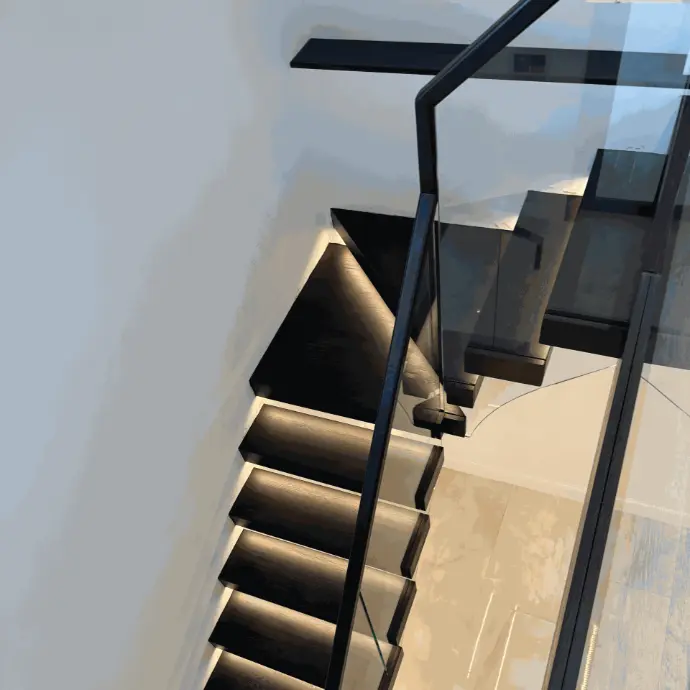Are Floating Stairs safe?
The stunning visual effect of a floating staircase—treads seemingly suspended in mid-air—often leads to the most important question: Are they safe?
The perceived fragility is purely visual. At Ovoms, we confidently state that a professionally designed and installed cantilever staircase is every bit as safe and structurally reliable as a traditional staircase, often exceeding standard building code requirements.
Here is a look at the engineering and regulation that guarantee the safety of every Ovoms floating stair installation.

The Secret is Hidden Support
The core of a floating stair's safety lies not in what you see, but in the powerful support system hidden within the wall.
The Cantilever Principle
Hidden Steel Stringer: We embed a robust, heavy-gauge steel stringer or a series of structural steel brackets directly into the wall framing. This structural component is securely anchored to the building's main supports.
Engineered Load Capacity: Each individual tread is rigidly secured to this hidden structure. Our designs are engineered for dynamic loads, meaning they account for the forces generated by walking, running, and heavy use. Our systems typically exceed the minimum safety requirements per tread by a substantial margin.
Zero Movement: The precision fabrication and installation guarantee zero unwanted movement, wobble, or flex, ensuring a solid, secure feel underfoot.
2. Meeting UK Building Regulations (Approved Document K)
A floating stair is a legitimate structure and must adhere to the same stringent safety standards as any conventional staircase in the UK. Ovoms meticulously ensures compliance with Approved Document K to address all safety concerns.
How to install Floating Stairs?
Installing a floating staircase is a highly specialised architectural project that demands careful planning, absolute precision, and strict adherence to safety standards. Unlike conventional stairs, the structural stability of floating treads relies entirely on hidden engineering.
While this guide provides a general overview, it underscores why a project of this nature must be entrusted to experts like Ovoms. The process varies depending on the chosen design: mono stringer, double plate, or Zig-Zag stairs.
Phase 1: Pre-Installation & Structural Preparation
1. Structural Assessment and Permitting
Before any physical work begins, Ovoms structural engineers complete all necessary calculations. This phase involves:
Obtaining Permits: Securing all required local building permits.
Wall Preparation: Assessing and often reinforcing the existing wall structure (using I-beams or structural lumber) that will bear the heavy cantilevered load.
Precise Measurement: Detailed laser measurements of the space are taken to determine the optimal placement, ensuring perfect alignment with the open design advantages and safety regulations (e.g., headroom clearance).
2. Fabrication and Support Installation
The complexity of the support structure defines the installation method:
Mono Stringer Stairs: A single, central steel stringer is secured first. This requires heavy-duty anchor bolts or custom welding to the floor/support beam, ensuring it is perfectly level and plumb before the treads are affixed.
Double Plate Stairs (True Floating/Cantilevered): This method involves installing two parallel steel plates or a robust inner stringer directly into the wall cavity. These plates are anchored to the structural frame using specialized fasteners and welded connections, designed to distribute the load across the wall.
Zig-Zag Stairs: These utilize a unique integrated support structure, often combining wall anchoring with a visible or hidden central stringer, creating the distinct alternating geometric profile while ensuring maximum stability.
Phase 2: Tread Installation and Precision Alignment
3. Fixing the Treads
Once the support structure is rigidly secured, the treads—chosen from materials like custom hardwood, glass, or metal—are installed.
Specialised Hardware: Treads are attached using bespoke brackets, sleeves, or high-strength epoxy designed specifically for the material and structural type.
Safety Alignment: Ensuring every tread is precisely level and maintaining the required uniform spacing is paramount. This adherence to consistent rise and run directly addresses safety concerns, providing a comfortable and secure walking surface.
Phase 3: Finishing and Code Compliance
4. Final Touches and Safety Certification
The final phase focuses on aesthetics and legal compliance:
Finishing: Any necessary sanding, staining, or application of protective coatings (like anti-slip finishes) is completed on the treads.
Railing Installation: Handrails and balusters must be installed last, following local building codes (e.g., UK Approved Document K). Ovoms installs systems like seamless glass balustrades or sleek cable systems that integrate visually while fulfilling all guarding regulations.
Inspection: The finished staircase undergoes final inspection to ensure complete safety and code compliance before the project is signed off.
In Conclusion

